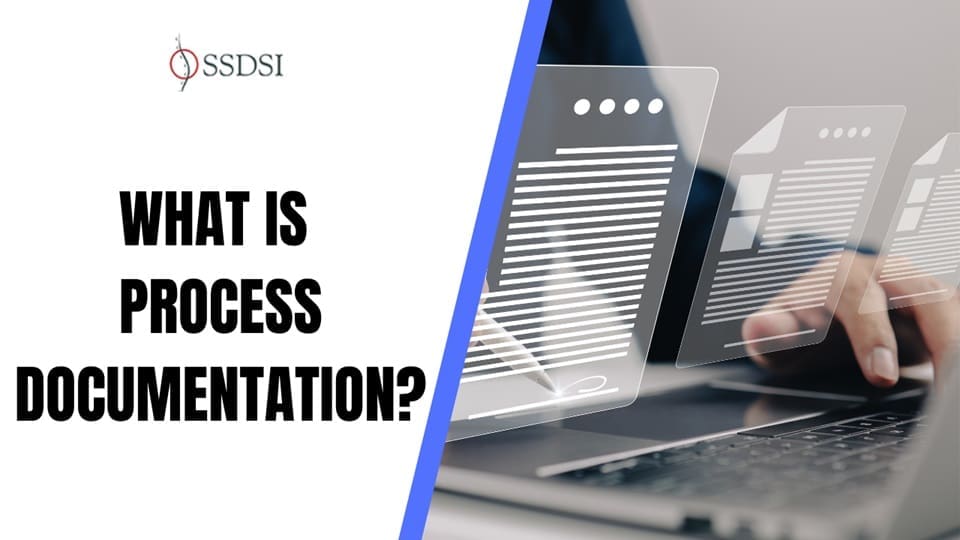Process documentation is the detailed and systematic recording of all steps required to complete a specific task or workflow within a business. This structured guide, often taking the form of written instructions, flowcharts, or checklists, provides a clear, step-by-step breakdown of how to perform specific operations consistently and efficiently.
Found within company resources like training manuals and standard operating procedures (SOPs), effective process documentation offers numerous benefits, including improved efficiency, reduced errors, and streamlined employee training. By documenting each step, businesses can also analyze and refine their workflows for continuous improvement.
Table of contents
What is a Process?
A process refers to a sequence of steps or interrelated activities that, when followed, lead to a specific outcome. Processes involve specific inputs (resources, data, or materials) that undergo a series of tasks, adding value at each stage to create a final output.
Every organization has processes that involve systems, applications, and people, all working together to complete a task or achieve a goal.
What is Documentation?
Documentation refers to capturing, narrating, or describing how a process functions. It’s a structured method of recording the activities, decisions, and steps taken to carry out a process, making it easier to understand, reflect upon, and improve the process.
What is Process Documentation?
Process documentation is the systematic recording of what happens during a process, how it happens, and why it happens, to analyze, reflect, and improve the process over time. It’s a powerful tool for understanding, improving, and communicating the details of a process, helping organizations and teams learn from past experiences, avoid repeating mistakes, and achieve better results.
Process documentation isn’t just about recording actions. It’s about identifying patterns, challenges, and successes that can lead to change. This allows organizations to learn internally, share knowledge with stakeholders, and even influence broader society by discussing issues that emerge from projects.
When documenting a process, there are several key steps:

- Identify the Process: Clearly define the task or workflow you are documenting and its purpose.
- Set Boundaries: Mark the start and end points of the process, defining when it begins and how to recognize its completion.
- List Expected Results: Clearly state the desired outcome or goal of the process.
- Detail Required Inputs: Identify the materials, tools, or resources needed to complete the task.
- Walk Through the Process: Either perform the task or observe someone doing it to capture every step accurately.
- Determine Who’s Involved: Note the roles of individuals or teams responsible for different steps in the process.
- Record in a Documentation System: Organize and store the details in a system where they can be reviewed and updated regularly.
History
The concept of process documentation originated in the Philippines in 1978. It was initially used in a project aimed at improving communal irrigation by creating effective farmer institutions for irrigation management. Social scientists worked closely with farmers, observing and documenting the formation and functioning of user groups.
The approach was called the “learning approach,” which emphasized experimenting with small pilot sites to generate knowledge. Unlike the “blueprint approach” that focused on rigid planning and pre-determined outcomes, the learning approach encouraged flexibility and continuous improvement based on real-time observations.
Purpose
The main objective of process documentation is to capture and analyze the implementation process, allowing us to adjust and improve strategies. In doing so, organizations gain insight into what’s working and what isn’t, allowing for modifications that lead to better outcomes.
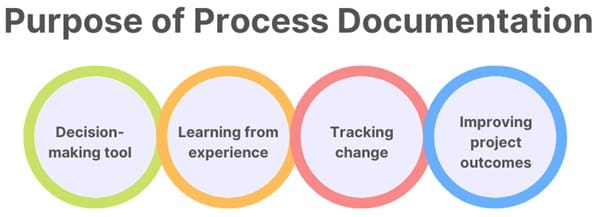
- Decision-making tool: By documenting processes, organizations can identify problems and bottlenecks. This helps in making informed decisions, taking corrective action, and fostering institutional learning.
- Learning from experience: Process documentation allows stakeholders to learn from past experiences and apply these lessons to improve the quality and impact of future projects.
- Tracking change: Process documentation captures the process of change, enabling organizations to understand what changes occurred, how they were achieved, and why.
- Improving project outcomes: By identifying positive and negative factors during a process, organizations can adjust their strategies to enhance success.
Key Aspects
Process documentation covers various aspects of a process:
- Stakeholder involvement: This section details how stakeholders participate in the process and addresses their concerns, issues, and interests.
- Key activities: This part describes the significant activities undertaken during the process and explains how decisions were made or conflicts were resolved.
- Outcome analysis: This section evaluates the results of the process, highlighting what worked well, what didn’t, and the reasons behind both outcomes.
Benefits of Process Documentation
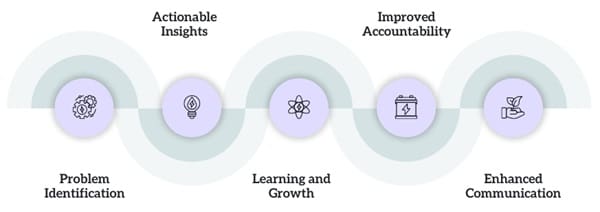
- Problem Identification: By documenting processes, organizations can identify deviations and problems early, allowing for prompt corrective action.
- Actionable Insights: The detailed recording of events provides valuable insights into what drives success or failure, leading to more effective decision-making.
- Learning and Growth: Process documentation fosters continuous learning by encouraging reflection on past experiences and sharing insights with stakeholders.
- Improved Accountability: By keeping a clear record of processes, organizations can improve transparency and accountability.
- Enhanced Communication: Documentation helps communicate insights to team members and stakeholders, ensuring everyone is on the same page.
Tools and Methods in Process Documentation
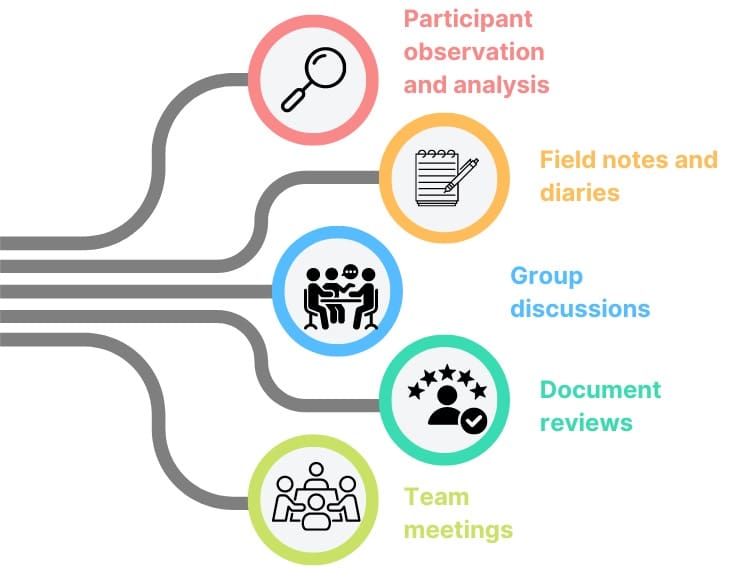
Process documentation uses a variety of tools and methods to gather and analyze information. Some of the most common tools include:
- Participant observation and analysis: Observing and analyzing the behavior and performance of participants (e.g., how a farmer group is functioning) to gain insights.
- Field notes and diaries: Regularly documenting observations and activities in written form to capture the day-to-day details of a process.
- Group discussions: Conducting focused group discussions to gather multiple perspectives and insights on a particular issue or process.
- Document reviews: Review meeting minutes, records, and written communications to gather data and identify trends or challenges.
- Team meetings: Discuss issues and challenges with the project team to develop solutions and share insights.
Also See: Lean Six Sigma Certification Programs, Oakland, California
Data Collection Methods for Process Documentation
The following methods are typically used to collect data for process documentation:
- Interviews: Engaging with individuals involved in the process to understand their perspectives, challenges, and contributions.
- Observation of meetings: Attending and observing key meetings to capture decisions, interactions, and the process in action.
- Photography or video: Using visual media to document the process and capture details that might not be easily recorded in written form.
- Review of documents: Analyzing relevant documents such as reports, records, and meeting notes to track progress and decisions.
Outputs of Process Documentation

The information gathered during process documentation can be presented in various formats to communicate findings and insights. Some common outputs include:
- Case studies: In-depth analysis of specific issues or challenges faced during the process.
- Monitoring and evaluation (M&E) reports: Qualitative descriptions of how process outputs were achieved and how they were used.
- Newsletters: Regular updates on project progress and key learnings for internal and external audiences.
- Reports: Comprehensive documents summarizing findings, successes, challenges, and recommendations for improvement.
- Discussion notes: Shorter documents focused on key points from discussions or meetings.
Process of Process Documentation
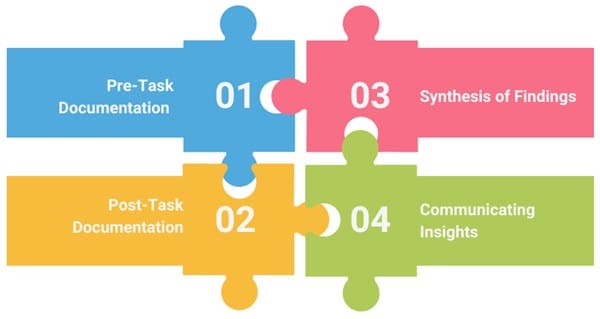
It is an ongoing activity. It requires continuous observation, recording, and reflection throughout a project’s lifecycle. Below are the key steps involved in process documentation:
Step 1: Pre-Task Documentation
Before starting any task, document the objective, approach, steps to take, and the stakeholders involved. This establishes a clear plan and sets the stage for the process.
Step 2: Post-Task Documentation
Immediately after completing a process task, document what you accomplished, including any modifications, successes, or challenges. Note key factors like indicators of success, the level of participation, and progress.
Step 3: Synthesis of Findings
After gathering feedback from stakeholders, synthesize the findings and insights. Analyze what worked, what didn’t, and why. This step helps organizations understand the factors that contribute to success or failure.
Step 4: Communicating Insights
In the final step, communicate the findings and insights to stakeholders. This feedback loop ensures that you act on the insights and make any necessary adjustments to the process.
Process Documentation in Development Projects
In development projects, process documentation is often used to track progress and ensure that the project is being implemented effectively. It’s an essential tool for managing information, ensuring that learning happens throughout the project lifecycle.
Unlike traditional monitoring and evaluation (M&E) approaches, process documentation focuses on the journey rather than just the end results. It provides a deeper understanding of the social, cultural, and institutional factors that influence the success or failure of a project.
Process documentation helps capture the nuances of development work, which often involves multiple stakeholders, evolving challenges, and complex decision-making processes. It allows organizations to adapt and improve their strategies, ensuring that the project has a lasting impact.
Final Words
Process documentation is an invaluable tool for organizations that want to improve their processes, learn from their experiences, and achieve better outcomes. By systematically recording the steps, decisions, and challenges of a process, organizations can gain valuable insights into what works, what doesn’t, and why. This leads to better decision-making, improved project outcomes, and continuous learning.
In essence, process documentation helps organizations move beyond simply recording activities to understanding the factors that drive success and failure. By doing so, they can improve their strategies, foster collaboration with stakeholders, and ensure that their projects have a lasting impact.

About Six Sigma Development Solutions, Inc.
Six Sigma Development Solutions, Inc. offers onsite, public, and virtual Lean Six Sigma certification training. We are an Accredited Training Organization by the IASSC (International Association of Six Sigma Certification). We offer Lean Six Sigma Green Belt, Black Belt, and Yellow Belt, as well as LEAN certifications.
Book a Call and Let us know how we can help meet your training needs.

